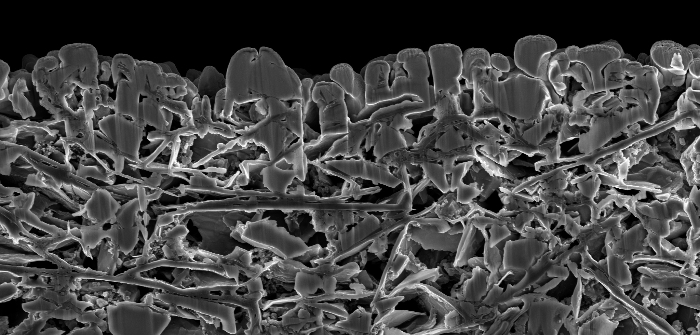New research led by WMG at the University of Warwick has utilized graphene girder reinforcement to replace the graphite in the anodes of lithium-ion batteries with silicon. The result is electrodes with extended lifetime. This means that is possible to create a rechargeable lithium-ion-based battery with twice the lifecycle.
Graphite has been the default choice for anodes in lithium-ion batteries since their original launch by Sony; but researchers and manufacturers have long sought a way to replace graphite with silicon, as it is an abundantly available element with 10 times the gravimetric energy density of graphite. Unfortunately, silicon has performance issues that continue to limit its commercial exploitation.
Due to volume expansion upon lithiation, silicon particles can electrochemically agglomerate in ways that impede further charge-discharge efficiency over time. Silicon is also not intrinsically elastic enough to cope with the strain of lithiation when it is repeatedly charged, leading to cracking, pulverization and rapid physical degradation of the anode’s composite microstructure. This contributes significantly to capacity fade, along with degradation events that occur on the counter electrode the cathode.
Numerous approaches have attempted to overcome these issues. The use of nano-sized and structured silicon particles with micron-sized graphene for example, but this has proved unsatisfactory. Using nano-sized silicon particles dramatically increases the amount of reactive surface available.
This leads to much more lithium being deposited on the silicon during the first charge cycle, therefore forming a solid-electrolyte interphase barrier between the silicon and the electrolyte, and thus greatly reducing the lithium inventory.
This layer also continues to grow on silicon and so the lithium loss becomes continuous. Other methods of incorporating other materials such as graphene at different sizes have been deemed impractical for largescale production.
However new research, led by WMG has developed a new anode mixture of silicon and a form of chemically modified graphene which could resolve these issues and create viable silicon anode lithium-ion batteries. Such an approach could be manufactured on an industrial scale and without the need to resort to nano sizing of silicon and its associated problems.
Graphene is of course a single, one atom thick layer of the mineral graphite. However, it also possible to separate and manipulate a few connected layers of graphene, which gives a material that researchers refer to as few-layer graphene (FLG).
Previous research has tested the use of FLG with nano-sized silicon but this new study has found that FLG can also dramatically improve the performance of larger micron-sized silicon particles when used in an anode. So much so that this mixture could significantly extend the life of lithium-ion batteries and also offer increased power capability.
The researchers created anodes that were a mixture of 60% micro silicon particles, 16% FLG, 14% Sodium/Polyacrylic acid, and 10% carbon additives, and then examined the performance over a 100 charge-discharge cycles.
The WMG research team has already begun further work on this technology, including further study and research as part of the graphene spearhead two-year project led by Varta Micro-innovations. The main goal of that project is to advance in pre-industrial production of silicon/graphene composites and their subsequent processing into lithium-ion batteries for high-energy and high-power applications.
February 1, 2018


